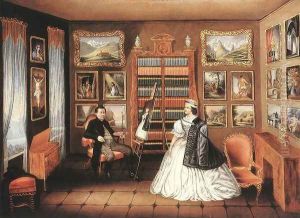Alajos Stech Paintings
Alajos Strobl, often mistakenly referred to as Alajos Stech, was a prominent Hungarian sculptor whose work represents a peak in the neoclassical and early Art Nouveau movement in Hungary. Born on June 21, 1846, in Szentgyörgy, which was then part of the Austrian Empire and is now known as Sveti Jurij in Slovenia, Strobl would go on to become one of the most influential sculptors of his time.
Strobl was initially trained at the Academy of Fine Arts Vienna, where he studied under some of the most respected artists of the era, such as Johann Preleuthner and Hanns Gasser. After completing his studies in Vienna, he continued his education at the Hungarian University of Fine Arts in Budapest. His talent was recognized early on and he received scholarships that allowed him to travel to and study in Rome, which was a center for classical art and sculpture.
Throughout his career, Alajos Strobl worked on numerous public monuments and statues, many of which still adorn the streets and squares of Budapest and other Hungarian cities. His style evolved over the years, starting with classical themes and techniques, and later incorporating elements of Art Nouveau and realism. One of his most famous works is the statue of the poet Mihály Vörösmarty in Budapest’s Vörösmarty Square, unveiled in 1908. He was also responsible for the sculpture of the Matthias Fountain, a monumental fountain group in the western forecourt of the Royal Palace of Budapest, considered one of the greatest pieces of Hungarian sculpture.
Strobl's influence extended beyond his sculptures, as he was a respected teacher at the Hungarian University of Fine Arts. His work and his teachings helped shape a new generation of Hungarian sculptors. Alajos Strobl passed away on December 13, 1922, in Budapest, leaving behind a legacy of artistic excellence that has had a lasting impact on Hungarian art. His works are celebrated for their dynamic composition, detailed craftsmanship, and the way they encapsulate the spirit of the era in which they were created.
